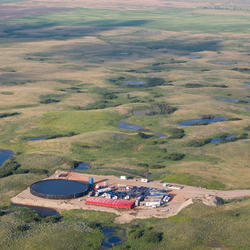Contaminant Transport and Effects
Contaminant Transport and Effects
Filter Total Items: 121
Large Fraction of Unidentified Organofluorine in a Coastal Watershed has Implications for River to Marine Ecosystems
A group of scientists investigated per- and polyfluoroalkyl substances (PFAS) in watersheds on Cape Cod and identified a unique signature for aqueous film forming foams (AFFF) from legacy firefighting and fire training. A combination of statistical modeling and laboratory measurements indicates that unidentified organofluorine constitutes a large fraction of PFAS in the river systems that...
Groundwater Discharge is a Pathway for Phytoestrogen and Herbicide Entry to Streams in the Chesapeake Bay Watershed
Groundwater discharge zones are important spawning areas for fish because they provide a thermally stable habitat. Research at three streams in the Chesapeake Bay Watershed with areas of focused groundwater discharge revealed that groundwater also is a source of phytoestrogens and herbicides that could result in fish exposure during sensitive life stages.
Assessment of Mercury and Selenium Accumulation in Upper Colorado River Basin Fish
More than 50 years of existing mercury and selenium concentrations in native and nonnative fish species residing in streams within the Upper Colorado River Basin were compiled and analyzed to provide an understanding of concentrations among different species, sampling years, and locations to determine potential health risks. Concentrations of mercury and selenium were above health benchmarks in 13...
Long-Term Monitoring Reveals How Water and Biota in Remote Lakes Respond Differently to Changes in Atmospheric Deposition of Mercury
A comparison of regional mercury atmospheric deposition data with water, yellow perch, and dragonfly larvae samples from lakes in Voyageurs National Park indicates that decreases in mercury emissions resulted in mercury reduction in water from these remote lakes, but mercury declines in biota were significant in only one of three lakes, likely because resident biota integrate exposure over much...
Advanced PFAS Measurement Methods
Environmental Health Program scientists, in collaboration with other USGS scientists, are developing complementary field and laboratory methods and capabilities to detect and quantify a range of target and nontarget per- and polyfluoroalkyl substances (PFAS) and indicator compounds at low levels (parts per trillion) in a variety of environmental matrices. The PFAS Integrated Science Team is...
Energy Integrated Science Team
The Energy Lifecycle Integrated Science Team focuses on the potential for contaminant exposures in the environment that might originate from energy resource activities including, extraction, production, transportation, storage, extraction, waste management and restoration. Perceived health risks to humans and other organisms will be distinguished from actual risks, if any. If actual risks are...
Bioaccumulation of Mercury in Fish Varied by Species and Location in the Chesapeake Bay Watershed—Summary of Existing Data and a Roadmap for Integrated Monitoring
Fish mercury data from State monitoring programs and research studies within the Chesapeake Bay were compiled and summarized to provide a comprehensive overview of the variation in fish mercury concentrations among species and habitats within the watershed. These data are put into context with existing health benchmarks for humans, birds, and fish. Scientists also provide a roadmap for an...
Mercury Accumulation in Waterbirds (Black Rails) Related to Sediment Chemistry in San Francisco Bay Wetlands
The U.S. Geological Survey (USGS) assessed the effect of sediment chemistry, food web structure, and diet on mercury bioaccumulation in black rails in the San Francisco Bay watershed. Differences in mercury accumulation in the birds were related to differences in sediment chemistry in the wetlands.
U.S. Geological Survey Research Scientist Recognized for Advancing Exposure Science
U.S. Geological Survey (USGS) Scientist Dana Kolpin was presented the International Environmental Award by Reciphram celebrating his research on the occurrence, sources, fate, and effects of environmental contaminants such as pharmaceuticals and pesticides.
Dragonfly Larvae are Effective Bioindicators of Mercury Exposure in Fish and Amphibians—Results of Citizen Science in 100 National Parks and Protected Places
Mercury concentrations were measured in dragonfly larvae across more than 450 sites in 100 national parks and protected places as part of a partnership among Federal agencies, academic researchers, and more than 4,000 citizen scientists. Mercury concentrations in dragonfly larvae were positively correlated with mercury concentrations in fish and amphibians living in the same aquatic environments...
Framework for Examining Stream Ecosystem Health in Areas of Shale Gas Development—A Multi-Parameter Watershed-Based Case Study in Pennsylvania
In a case study of 25 headwater streams in Pennsylvania, no statistically significant associations were determined between shale gas development and geochemical tracers of produced waters or measures of microbial and macroinvertebrate community composition. Although the results are specific to the region studied, the integrated biological and geochemical framework provides a tool for examining...
How are Mercury Sources Determined?
USGS scientists use innovative isotopic identification methods to determine mercury sources in air, water, sediments, and wildlife.













